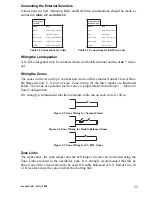
2
Cabling
The panel has high voltage barriers between the a.c. mains supply and the alarm wiring
terminals. It is essential that these barriers are maintained in the way the cables enter the
cabinet, are routed inside the cabinet, and are routed externally.
Additional holes must not be cut in the enclosure, rear entry points are provided for
cables. Alarm system cables must be neatly trimmed and not be allowed to loop inside
the cabinet.
Cables external to the cabinet must be either firmly affixed to the fabric of the building
using suitable clips or saddles, or mechanically protected in conduit or trunking. It must
not be possible to put strain on the wiring within the control cabinet by pulling on cabling
external to the cabinet.
It must not be possible to push a finger or similar size object or instrument into any hole
or cable entry point.
Mains Supply Connections
The connection to the a.c. mains supply must be made by a competent, qualified person,
for example NICEIC approved, in accordance with the current IEE and local supply
regulations.
Warning:
A means of isolation from the mains supply must be provided within
two metres of the control panel. Where live and neutral supplies can
be identified, a fused spur with a 3A fuse, must be fitted on the live
circuit. Where live and neutral circuits cannot be reliably identified,
3A fuses must be fitted to both circuits.
Where a flexible cable is connected to the control having cores coloured brown and blue
it is important to connect the wires to the mains terminal block as follows:
• Blue (Neutral) – connect to terminal N
• Brown (Live) – connect to terminal L
Where a non-flexible cable is connected to the control having cores coloured red with
black sleeves, it is important to connect the wires according to the following code:
• Black (Neutral) – connect to terminal N
• Red (Live) – connect to terminal L
Note: No connections should be made to the Earth terminal (marked E) or on the
mains terminal block.
The insulation of each conductor must be prepared and connected such that no part of
the bare conductor is visible or protruding outside the terminal block. In the case of
standard conductors, all strands must be twisted together and firmly clamped in the mains
terminal block.
The outer covering insulation must be clamped under the cable clamp. It is important
that this cable enters the control panel enclosure through the mains entry hole under the
mains terminal block, is not looped within the control panel enclosure and does not run
Содержание ACCORD XPC
Страница 1: ...Installation Manual ...
Страница 2: ......
Страница 12: ...6 ...
Страница 48: ...42 ...
Страница 56: ...50 ...
Страница 61: ...55 Accord xpC July 2001 ...
Страница 62: ...56 IE1 1230 63 Issue D ...









































